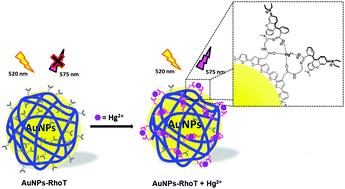Optical chemosensors for Hg2+ from terthiophene appended rhodamine derivatives: FRET based molecular and in situ hybrid gold nanoparticle sensors†
Abstract
A multifunction sensor based on rhodamine B with a terthiophene substituent has been developed as a highly sensitive chemosensor for Hg2+. This method is mainly based on Hg2+-induced spirocycle opening leading to fluorescence and colorimetric enhancement. The binding properties of a terthiophene appended rhodamine based fluorescence chemosensor (RhoT) was studied using the fluorescence resonance energy transfer (FRET) process, and RhoT displayed highly selective fluorescence enhancement and a color change in the presence of Hg2+. Moreover, the in situ formation of gold nanoparticle/conducting polymer nanocomposite based-chemosensors (AuNPs-RhoT) was achieved to explore the sensitive and selective detection of Hg2+ in aqueous solution over 12 other metal ions using a colorimetric technique. The hybrid sensor became aggregated in solution in the presence of Hg2+ by an ion-templated chelation process, which caused an easily measurable change in the emission spectrum of the particles and provided an inherently sensitive method for Hg2+ detection in aqueous solution.


 Please wait while we load your content...
Please wait while we load your content...